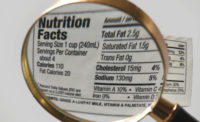Difference in the details
Want to improve food safety? Take a closer look at equipment design, plant conditions.

Nearly a decade after the American Meat Institute (AMI) released its “10 Principles of Sanitary Equipment Design,” one expert finds food processors still trying to prevent product contamination … but not leveraging AMI’s equipment design recommendations.
Kurt Warzynski is manager of process engineering, Food & Beverage Division, at Stellar, a design-build services company headquartered in Jacksonville, Fla.
“On equipment, the most common cause of food-safety problems is the lack of knowledge and recognition that there is a problem or an equipment sanitary-design flaw,” he says. “While most manufacturers are aware of the basic principles, they often lack the food-safety knowledge as it relates to equipment manufacturing or resources to implement a solution to the equipment design. In some cases they simply fail to aggressively police the standards they’ve set.”
Warzynski says many food operations officials struggle with increasingly fast-paced project schedules and limited funds. This affects priorities assigned to sanitary equipment design and requirements during the early stages of any project.
“It’s incredibly important that manufacturers take the time to define equipment sanitary requirements with their engineers and equipment suppliers – early on before the equipment design begins,” he says. “Then, it’s important to follow through with those requirements.”
Warzynski says food processors can save significant capital dollars if they invest the time to “engineer out the problem” when first designing a new line – rather than wait to correct issues discovered after installation.
Warzynski describes a few “typical” sanitary design issues and areas involving machines that have been overlooked or not policed properly.
Nooks, cracks and crevices
At its core, sanitary equipment design is about controlling potential harborage areas where undesirable microorganisms may cultivate. Everything must be analyzed in detail to ensure there are no nooks, cracks or crevices where microbial hazards can develop.
Equipment feet
“Even things like the feet of the equipment must be looked at,” says Warzynski. “Do you use a ball foot, screw foot, welded-insert foot, plastic foot, or stainless steel foot? How do you anchor the feet to the floor so you don’t create a space for potential harborage?”
Equipment should be designed with the minimum required number of legs to reduce harborage possibilities.
Wire attachments
Warzynski says another overlooked common detail involves wire attachments. “For example, when running cord for a photo-eye sensor on a machine, often we’ll see the cord plastic tie wrapped to the tubing,” he notes. “It would be better to use proper wiring harnesses to stand the cords off to create space between the cord and equipment for cleaning.”
Off-the-shelf equipment
Another reason to communicate early with equipment manufacturers is to avoid issues with off-the-shelf equipment.
“For example, a piece of equipment may have several mounting hole options,” says Warzynski. “If the manufacturer has only elected some equipment options there are still holes punched in the steel for the other options. So now you’ve got bolts in just a few of the holes, and others are now open spaces allowing microorganisms to accumulate.”
Custom equipment design eliminates unwanted mounting holes that may be present in off-the-shelf equipment.

Nearly a decade after the American Meat Institute (AMI) released its “10 Principles of Sanitary Equipment Design,” one expert finds food processors still trying to prevent product contamination … but not leveraging AMI’s equipment design recommendations.
Kurt Warzynski is manager of process engineering, Food & Beverage Division, at Stellar, a design-build services company headquartered in Jacksonville, Fla.
“On equipment, the most common cause of food-safety problems is the lack of knowledge and recognition that there is a problem or an equipment sanitary-design flaw,” he says. “While most manufacturers are aware of the basic principles, they often lack the food-safety knowledge as it relates to equipment manufacturing or resources to implement a solution to the equipment design. In some cases they simply fail to aggressively police the standards they’ve set.”
Warzynski says many food operations officials struggle with increasingly fast-paced project schedules and limited funds. This affects priorities assigned to sanitary equipment design and requirements during the early stages of any project.
“It’s incredibly important that manufacturers take the time to define equipment sanitary requirements with their engineers and equipment suppliers – early on before the equipment design begins,” he says. “Then, it’s important to follow through with those requirements.”
Warzynski says food processors can save significant capital dollars if they invest the time to “engineer out the problem” when first designing a new line – rather than wait to correct issues discovered after installation.
Warzynski describes a few “typical” sanitary design issues and areas involving machines that have been overlooked or not policed properly.
Nooks, cracks and crevices
At its core, sanitary equipment design is about controlling potential harborage areas where undesirable microorganisms may cultivate. Everything must be analyzed in detail to ensure there are no nooks, cracks or crevices where microbial hazards can develop.
Equipment feet
“Even things like the feet of the equipment must be looked at,” says Warzynski. “Do you use a ball foot, screw foot, welded-insert foot, plastic foot, or stainless steel foot? How do you anchor the feet to the floor so you don’t create a space for potential harborage?”
Equipment should be designed with the minimum required number of legs to reduce harborage possibilities.
Wire attachments
Warzynski says another overlooked common detail involves wire attachments. “For example, when running cord for a photo-eye sensor on a machine, often we’ll see the cord plastic tie wrapped to the tubing,” he notes. “It would be better to use proper wiring harnesses to stand the cords off to create space between the cord and equipment for cleaning.”
Off-the-shelf equipment
Another reason to communicate early with equipment manufacturers is to avoid issues with off-the-shelf equipment.
“For example, a piece of equipment may have several mounting hole options,” says Warzynski. “If the manufacturer has only elected some equipment options there are still holes punched in the steel for the other options. So now you’ve got bolts in just a few of the holes, and others are now open spaces allowing microorganisms to accumulate.”
Custom equipment design eliminates unwanted mounting holes that may be present in off-the-shelf equipment.
Looking for a reprint of this article?
From high-res PDFs to custom plaques, order your copy today!





